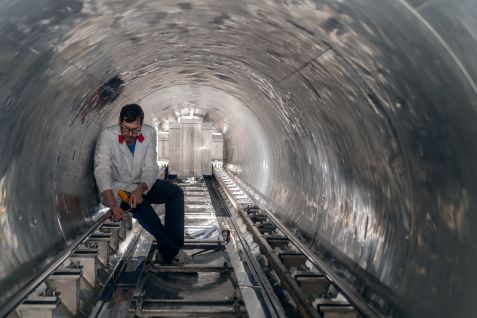MLZ is a cooperation between:
 > Technische Universität München
> Technische Universität München > Helmholtz-Zentrum Hereon
> Helmholtz-Zentrum Hereon
 > Forschungszentrum Jülich
> Forschungszentrum Jülich
MLZ is a member of:
 > LENS
> LENS > ERF-AISBL
> ERF-AISBL
MLZ on social media:

MLZ (eng)
Lichtenbergstr.1
85748 Garching
10.08.2020
Neutron scattering experiments show surprising reaction of magnetic nanoparticles to magnetic fields
Static description model for magnetic nanoparticles is not sufficient

Small-angle scattering instrument KWS-1 operated by Forschungszentrum Jülich at the Heinz Maier-Leibnitz Zentrum in Garching (left in picture). © Märkl, Dick, Häberle / TU München
Magnetic nanoparticles react differently to an external magnetic field than was previously expected. This has been shown in a study by an international research team with the participation of Forschungszentrum Jülich using neutron scattering at the Heinz Maier-Leibnitz Centre in Garching.
To the surprise of the researchers, the magnetic core of the particles is seen to grow as a result of the exposure. The scientists’ investigations enable a more precise understanding to be gained of the structure and behaviour of particles in a magnetic field. This is an important step in the realization of sophisticated technical applications using such particles, for example, in achieving higher storage density in the computers of the future, or developing better battery technologies. The medical field is also interested in magnetic nanoparticles: with their help, specific areas of the body can be targeted with heat therapy in order to treat cancer.

View into the detector tube of the Jülich small-angle scattering instrument KWS-1. © Andreas Heddergott/TUM
Until now, the current state of research has been that magnetism in nanoparticles occurs essentially in the core of the particles. Here, the atoms have a certain order, so that the magnetic moments or spins, i.e. the intrinsic angular momentum of the electrons, can be regularly aligned. By contrast, in the structurally disordered surface area of nanoparticles, the spins are randomly aligned, so that no order and thus no magnetism can ensue.
However, scientists from Forschungszentrum Jülich, the University of Cologne, the University of Prague and the international neutron research centre Institut Laue-Langevin have now shown by means of neutron scattering on cobalt ferrite nanoparticles that the structure of magnetic nanoparticles changes in the magnetic field.
In their experiments, the magnetic core volume increased by up to 20% when an external magnetic field was applied, while the thickness of the disordered surface area was reduced to less than half. The researchers explain this by the fact that the applied magnetic field brings some of the previously disordered spins into an order aligned with magnetization in the particles’ core. The widely used static description model for magnetic nanoparticles is clearly not sufficient and must be extended to include a component that is dependent on the magnetic field.
The researchers were able to demonstrate the shrinkage of the superficial, non-magnetic layer using a special neutron scattering method at the KWS-1 small-angle scattering instrument, operated by Forschungszentrum Jülich at its outstation at the Heinz Maier-Leibnitz Zentrum in Garching. “Polarization analysis using small-angle scattering in strong magnetic fields requires special instruments and a high neutron flux, provided by only a few neutron sources, along with years of experience”, explains Dr. Artem Feoktystov, KWS-1 instrument scientist at the Jülich Centre for Neutron Science. “We are one of the few neutron research facilities in the world that regularly perform such studies in magnetic fields of up to 3 Tesla.” Through polarization analysis, the researchers were able to identify and measure the regions of particles whose spins are not ordered.
Original Publication:
D. Zákutná et al.;
Field-Dependence of Magnetic Disorder in Nanoparticles,
Phys. Rev. X 10, 031019 – Published 24 July 2020, DOI: 10.1103/PhysRevX.10.031019
- Press release „Magnetic nanoparticles change their magnetic structure in a magnetic field“ of the University of Cologne from July 27, 2020: https://portal.uni-koeln.de/en/universitaet/aktuell/press-releases/single-news/magnetic-nanoparticles-change-their-magnetic-structure-in-a-magnetic-field
- Jülich Centre for Neutron Science: https://www.fz-juelich.de/jcns/EN/Home/home_node.html
- Small angle scattering diffractometer KWS-1 at Heinz Maier-Leibnitz Zentrum: https://mlz-garching.de/kws-1
Contact:
Dr. Artem Feoktystov
Jülich Centre for Neutron Science am Heinz Maier-Leibnitz Zentrum
Tel: 089/289-10746
E-Mail: a.feoktystov@fz-juelich.de
Press contact:
Angela Wenzik, Wissenschaftsjournalistin
Forschungszentrum Jülich
Tel: 02461 61-6048
E-Mail: a.wenzik@fz-juelich.de
MLZ is a cooperation between:
 > Technische Universität München
> Technische Universität München > Helmholtz-Zentrum Hereon
> Helmholtz-Zentrum Hereon
 > Forschungszentrum Jülich
> Forschungszentrum Jülich
MLZ is a member of:
 > LENS
> LENS > ERF-AISBL
> ERF-AISBL
MLZ on social media:


